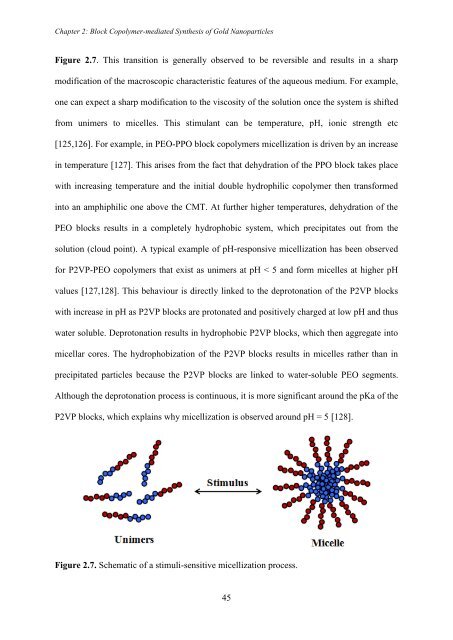PHYS01200704032 Debes Ray - Homi Bhabha National Institute
PHYS01200704032 Debes Ray - Homi Bhabha National Institute
PHYS01200704032 Debes Ray - Homi Bhabha National Institute
Create successful ePaper yourself
Turn your PDF publications into a flip-book with our unique Google optimized e-Paper software.
Chapter 2: Block Copolymer-mediated Synthesis of Gold Nanoparticles<br />
Figure 2.7. This transition is generally observed to be reversible and results in a sharp<br />
modification of the macroscopic characteristic features of the aqueous medium. For example,<br />
one can expect a sharp modification to the viscosity of the solution once the system is shifted<br />
from unimers to micelles. This stimulant can be temperature, pH, ionic strength etc<br />
[125,126]. For example, in PEO-PPO block copolymers micellization is driven by an increase<br />
in temperature [127]. This arises from the fact that dehydration of the PPO block takes place<br />
with increasing temperature and the initial double hydrophilic copolymer then transformed<br />
into an amphiphilic one above the CMT. At further higher temperatures, dehydration of the<br />
PEO blocks results in a completely hydrophobic system, which precipitates out from the<br />
solution (cloud point). A typical example of pH-responsive micellization has been observed<br />
for P2VP-PEO copolymers that exist as unimers at pH < 5 and form micelles at higher pH<br />
values [127,128]. This behaviour is directly linked to the deprotonation of the P2VP blocks<br />
with increase in pH as P2VP blocks are protonated and positively charged at low pH and thus<br />
water soluble. Deprotonation results in hydrophobic P2VP blocks, which then aggregate into<br />
micellar cores. The hydrophobization of the P2VP blocks results in micelles rather than in<br />
precipitated particles because the P2VP blocks are linked to water-soluble PEO segments.<br />
Although the deprotonation process is continuous, it is more significant around the pKa of the<br />
P2VP blocks, which explains why micellization is observed around pH = 5 [128].<br />
Figure 2.7. Schematic of a stimuli-sensitive micellization process.<br />
45

















